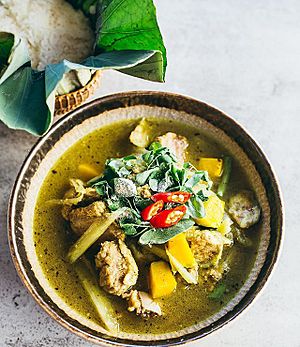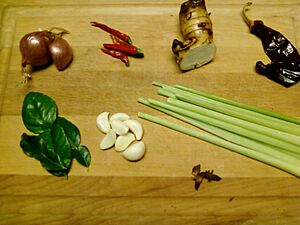Kroeung facts for kids
Kroeung (Khmer: គ្រឿង, romanized: krœăng, IPA: [krɨəŋ]) is a special mix of spices and herbs from Cambodia. It's like the secret ingredient that gives many Cambodian dishes their amazing flavor! You'll often see dishes named with "-kroeung" at the end, showing they use this paste.
Traditionally, people make kroeung by hand. They use a big bowl called a mortar and a tool called a pestle to grind the ingredients together. It's a lot of work! But today, some people use food processors to make it faster.
Many different ingredients can go into kroeung, depending on the recipe and what the cook likes. The most common ones are lemongrass, kaffir lime zest (from the rind of a special lime) and leaves, galangal (a root like ginger), turmeric (which makes things yellow), garlic, shallots (like small onions), dried red chilies, and other roots like fingerroot. This herbal paste is super important for making real Cambodian food taste just right.
Kroeung has two main types: "individual kroeung" and "royal kroeung". Individual kroeung is made for specific dishes and might have extra ingredients. Royal kroeung is more standard and doesn't change much. We can also tell different kroeung apart by their colors: yellow, green, and red. These colorful pastes are often used for stuffings, soups, and stir-fries.
Contents
Individual Kroeung: Unique Flavors for Specific Dishes
This type of kroeung is made for one special dish or has a unique use. Individual kroeung often includes extra ingredients that aren't in the basic recipe.
For example, a soup called Samlar kakou needs roasted ground rice in its kroeung. This gives the soup a smoky flavor. The kroeung for fish amok is also an individual type. It uses the red kroeung base but leaves out Turmeric and adds Kaffir lime leaves instead.
Sometimes, traditional kroeung recipes for curries use whole spices ground with the herbs. But if curry powder is used instead of whole spices, that kroeung is also considered an individual kroeung.
Royal Kroeung: A Special Blend
Royal kroeung is based on the pastes used for dishes served to royalty. The main difference between royal and individual kroeung is that royal kroeung sometimes includes extra ingredients like coriander and kaffir lime leaves (instead of just the zest).
Not every royal kroeung uses these two extra ingredients. But if they are added or swapped in the original recipe, it becomes a royal kroeung.
People from Cambodia living in other countries often use kaffir lime leaves instead of kaffir lime zest. This is because kaffir limes are not easy to find outside of Cambodia and the Southeast Asian region.
Colorful Kroeung: Red, Green, and Yellow
All kroeung can be put into three main color groups: red, green, and yellow. The main herb or spice in the paste gives it its color. It's interesting to know that uncooked kroeung often changes color as it cooks!
The ingredients in these colorful kroeung can change depending on the recipe. Some ingredients are even added just to give the paste its color.
Red Kroeung: Spicy and Vibrant
Red kroeung (Khmer: គ្រឿងក្រហម, krœăng krâhâm) gets its deep color from a type of dried chili. This chili doesn't add much flavor but gives the paste its natural red color. Sometimes, hotter chilies are added if the dish is meant to be very spicy.
This paste uses lemongrass stalks, not the leaves. The stalks are pale, so they easily take on the red color from the chilies. The ingredients for red kroeung are:
- Lemongrass stalk (ស្លឹកគ្រៃ, slœ̆k krey)
- Turmeric (រមៀត, rômiĕt)
- Shallot (ខ្ទឹមក្រហម, khtœ̆m krâhâm)
- Garlic (ខ្ទឹមស, khtœ̆m sâ)
- Galangal (រំដេង, rumdéng)
- Dried red pepper (ម្ទេសក្រហមស្ងួត, mtés krâhâm snguŏt)
Before pounding, the dried chili needs to be soaked, have its seeds removed, and then drained. Lemongrass stalks should be thinly sliced, and fresh galangal should be diced. If you use fresh turmeric, it also needs to be diced. Kaffir lime zest is sliced into thin strips, and the leaves are chopped after removing their veins.
Then, all the ingredients are added to the mortar and pounded. Usually, the lime zest or leaves go first until smooth. Then come the chili, lemongrass, galangal, and turmeric, pounded until the paste turns a deep red. Finally, garlic and shallots are added.
Green Kroeung: Fresh and Flavorful
The usual ingredients for a green kroeung are lemongrass (mostly leaves, with some stalks), rhizome (another root), cinnamon, galangal, and turmeric.
Sometimes, prahok (a fermented fish paste) can be added, depending on the dish. A version with prahok, but without cinnamon, is called teuk kroeung. This is used as a dipping sauce for fresh or lightly cooked vegetables, often eaten with rice as a side dish or a whole meal.
Yellow Kroeung: Everyday Cambodian Taste
Yellow kroeung is often used in common, everyday Cambodian dishes. A great example is samlor machu kroeung. This is a stew made with a yellow kroeung base. The paste turns a bit greenish when cooked. It also has fatty pieces of pork (usually ribs), tralach (wintermelon), papaya or tamarind for a sour taste, and trakuon (waterspinach).
The main ingredient that gives yellow kroeung its color is turmeric. To this, lemongrass stalks, garlic, shallots, and galangal are added.
See also
 In Spanish: Kroeung para niños
In Spanish: Kroeung para niños





